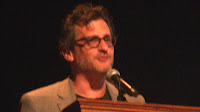 |
| Ben Mankiewicz at 2018 Virginia Film Festival |
Mankiewicz has been a frequent guest presenter at the Virginia Film Festival in Charlottesville. In 2011, for instance, he introduced the 1973 Terrence Malick film, Badlands, and moderated a discussion with actress Sissy Spacek and designer Jack Fisk. This year, he will be interviewing Peter Bogdanovich (via Skype) about the “new” Orson Welles film, The Other Side of the Wind, and he has introduced two classic horror films.
Movies are in Ben Mankiewicz's blood: He is the cousin of screenwriter Tom Mankiewicz (credits include Diamonds Are Forever, Live and Let Die, and TV's Hart to Hart), grandson of screenwriter Herman J. Mankiewicz (Citizen Kane, The Wizard of Oz, The Pride of the Yankees, among many other credits), and great-nephew of screenwriter, producer, and director Joseph L. Mankiewicz (inter alia, All About Eve, Guys and Dolls, Julius Caesar).
I spoke with Mankiewicz on November 3 after a screening of George A. Romero’s 1968 film, Night of the Living Dead at the Violet Crown cinema on Charlottesville's downtown mall. This transcribed interview has been slightly condensed and edited for clarity.
RS: Last night you introduced Bride of Frankenstein; tonight you introduced Night of the Living Dead, separated by about 30 years. What were their impacts on film making? They obviously are iconic films.
Night of the Living Dead is one of the most important horror films ever made. Bride of Frankenstein, I think, is one of the best, certainly from different eras. Night of the Living Dead was made during the era, 1967 to 1976, when independent, auteur filmmaking in America was taking over -- really the ten best years of American film making. It was, and then Night of the Living Dead is a good example of that.
Bride of Frankenstein is studio film making at its finest, so they came from completely different systems. Bride of Frankenstein is not as influential as Frankenstein, because it came first, although it’s probably a better film.
It seemed to be a better film to me, watching it last night. What animated George Romero in making this film? Obviously, he had a very low budget, was working largely with what looked like amateur actors, people from community theater…
A lot of just townspeople obviously playing the zombies.
How did he put it all together? Did he know he was creating a genre?
No, no. He certainly didn’t. I mean, he had an interest, there was already zombie culture that was already a thing but he sort of figured out how they looked, how they moved, how they walked (at least on screen). [He worked] creatively with writer John Russo, who he co-wrote it with. They just set the template because there was no rule, right? You can have them do anything. And so all the things we now know, like shooting a zombie in the head, or burn them [Romero invented], because he had the news man explain it.
If I’m not mistaken, the news man [played by Charles Craig], he wrote his own stuff. That’s why it sounds so authentic. He was a real news man, if I remember correctly. But that’s certainly the way it sounds to me. Romero was like, 'Look, here’s the information I want conveyed, now you frame that and say it like it was a real news story.'
Now obviously Romero went on to make several sequels but the actors in the film, I don’t think I’ve seen any of them anywhere again.
They acted a little bit. [Leading man] Duane Jones acted a little bit. He always thought that people would identify him as Ben throughout his career. Some others worked but no, nobody went on to win an Oscar.
That’s true. Well, Ben Mankiewicz, thanks for coming to the Virginia Film Festival. I appreciate your taking time to talk to me.
Oh, I love Charlottesville, I love coming. My pleasure.
The complete audio interview with Ben Mankiewicz will be available for listening on The Score from Bearing Drift, a weekly podcast, on November 10.
No comments:
Post a Comment